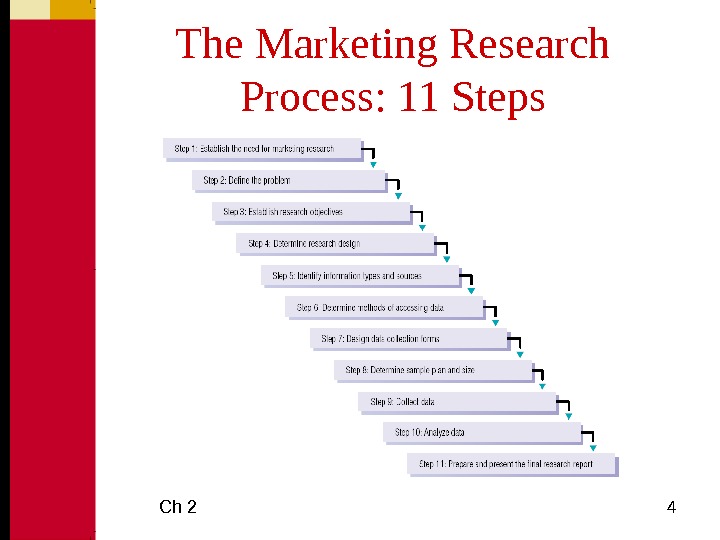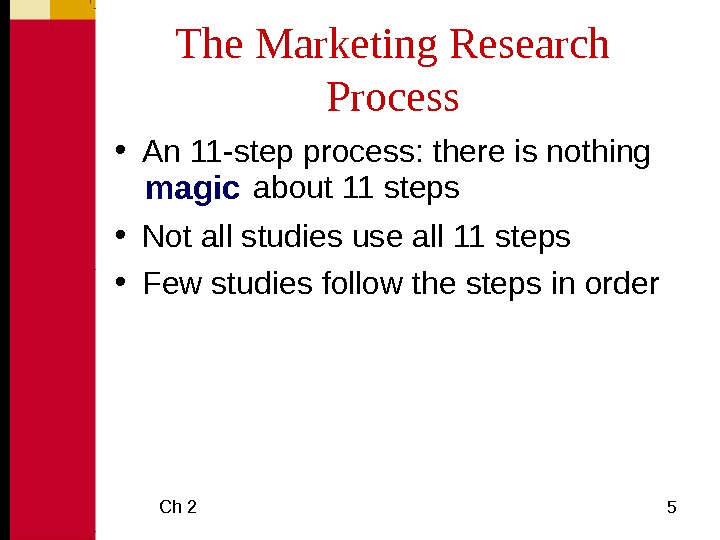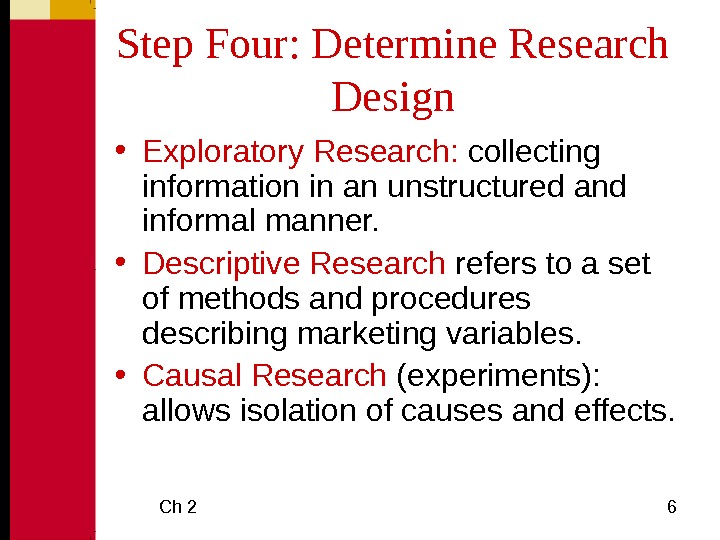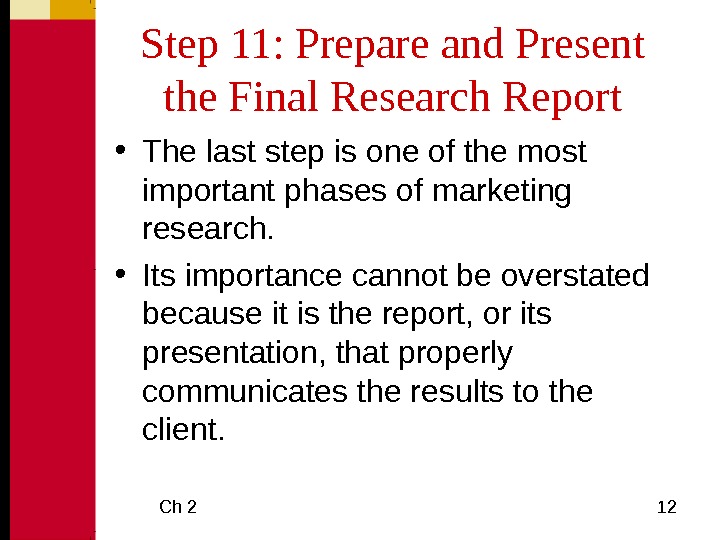Презентация marketing research process













- Размер: 163.5 Кб
- Количество слайдов: 12
Описание презентации Презентация marketing research process по слайдам
 The Marketing Research Process
The Marketing Research Process
 Ch 2 2 The Marketing Research Process: 11 Steps • Step One: Establishing the Need for Marketing Research • Step Two: Defining the Problem • Step Three: Establishing Research Objectives • Step Four: Determining Research Design • Step Five: Identifying Information Types and Sources • Step Six: Determining Methods of Accessing Data
Ch 2 2 The Marketing Research Process: 11 Steps • Step One: Establishing the Need for Marketing Research • Step Two: Defining the Problem • Step Three: Establishing Research Objectives • Step Four: Determining Research Design • Step Five: Identifying Information Types and Sources • Step Six: Determining Methods of Accessing Data
 Ch 2 3 The Marketing Research Process: 11 Steps • Step Seven: Designing Data Collection Forms • Step Eight: Determining Sample Plan and Size • Step Nine: Collecting Data • Step Ten: Analyzing Data • Step Eleven: Preparing and Presenting the Final Report
Ch 2 3 The Marketing Research Process: 11 Steps • Step Seven: Designing Data Collection Forms • Step Eight: Determining Sample Plan and Size • Step Nine: Collecting Data • Step Ten: Analyzing Data • Step Eleven: Preparing and Presenting the Final Report
 Ch 2 4 The Marketing Research Process: 11 Steps
Ch 2 4 The Marketing Research Process: 11 Steps
 Ch 2 5 The Marketing Research Process • An 11 -step process: there is nothing • Not all studies use all 11 steps • Few studies follow the steps in order magic about 11 steps
Ch 2 5 The Marketing Research Process • An 11 -step process: there is nothing • Not all studies use all 11 steps • Few studies follow the steps in order magic about 11 steps
 Ch 2 6 Step Four: Determine Research Design • Exploratory Research: collecting information in an unstructured and informal manner. • Descriptive Research refers to a set of methods and procedures describing marketing variables. • Causal Research (experiments): allows isolation of causes and effects.
Ch 2 6 Step Four: Determine Research Design • Exploratory Research: collecting information in an unstructured and informal manner. • Descriptive Research refers to a set of methods and procedures describing marketing variables. • Causal Research (experiments): allows isolation of causes and effects.
 Ch 2 7 Step 5: Identify Information Types and Sources • Primary information: information collected specifically for the problem at hand • Secondary information: information already collected
Ch 2 7 Step 5: Identify Information Types and Sources • Primary information: information collected specifically for the problem at hand • Secondary information: information already collected
 Ch 2 8 Step 6: Determine Methods of Accessing Data • Secondary data is relatively easy to access; primary data is more complex. • Three main choices for primary data: – Have a person ask questions – Use computer assisted or direct questioning – Allow respondents to answer questions themselves without computer assistance
Ch 2 8 Step 6: Determine Methods of Accessing Data • Secondary data is relatively easy to access; primary data is more complex. • Three main choices for primary data: – Have a person ask questions – Use computer assisted or direct questioning – Allow respondents to answer questions themselves without computer assistance
 Ch 2 9 Step 7: Design Data Collection Forms • Questionnaire must be worded objectively, clearly, and without bias in order to communicate with respondents. • Software programs are available to assist marketing researchers in preparing forms.
Ch 2 9 Step 7: Design Data Collection Forms • Questionnaire must be worded objectively, clearly, and without bias in order to communicate with respondents. • Software programs are available to assist marketing researchers in preparing forms.
 Ch 2 10 Step 8: Determine Sample Plan and Size • Sample plan refers to the process used to select units from the population to be included in the sample. • Sample size refers to determining how many elements of the population should be included in the sample.
Ch 2 10 Step 8: Determine Sample Plan and Size • Sample plan refers to the process used to select units from the population to be included in the sample. • Sample size refers to determining how many elements of the population should be included in the sample.
 Ch 2 11 Step 10: Analyze Data • Data analysis involves entering data into computer files, inspecting data for errors, and running tabulations and various statistical tests. • Data cleaning is a process by which raw data are checked to verify that the data have been correctly inputted from the data collection form to the computer software program.
Ch 2 11 Step 10: Analyze Data • Data analysis involves entering data into computer files, inspecting data for errors, and running tabulations and various statistical tests. • Data cleaning is a process by which raw data are checked to verify that the data have been correctly inputted from the data collection form to the computer software program.
 Ch 2 12 Step 11: Prepare and Present the Final Research Report • The last step is one of the most important phases of marketing research. • Its importance cannot be overstated because it is the report, or its presentation, that properly communicates the results to the client.
Ch 2 12 Step 11: Prepare and Present the Final Research Report • The last step is one of the most important phases of marketing research. • Its importance cannot be overstated because it is the report, or its presentation, that properly communicates the results to the client.

